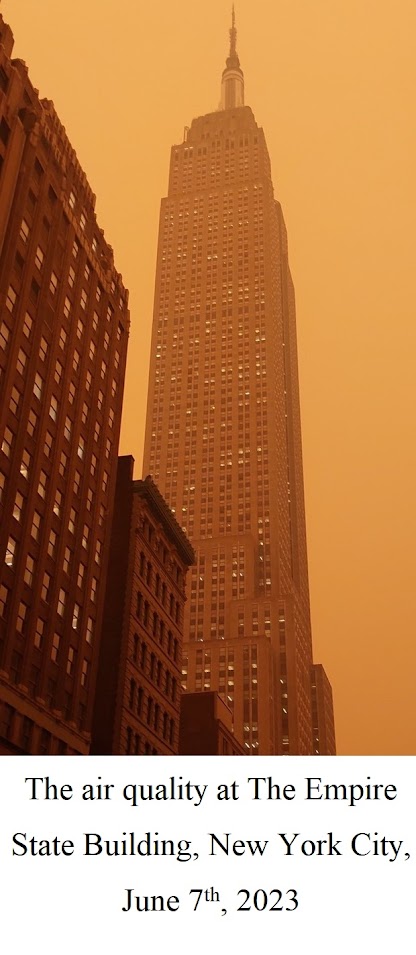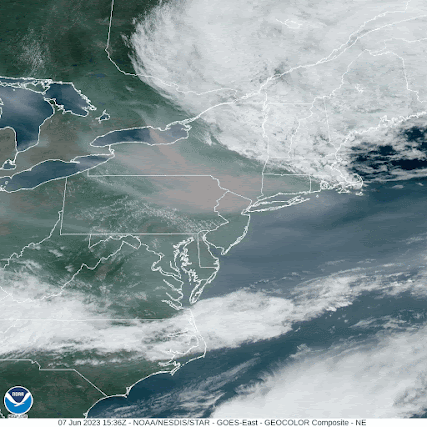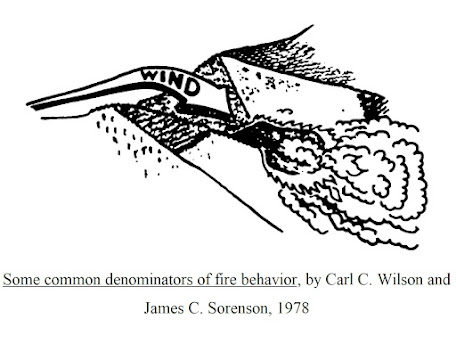Forest
fires, wildfires, brushfires, conflagrations, infernos, global cataclysms! It doesn’t matter what you called them, but it
seems like everyone was talking about them on June 7th, as the smoke
from the Canadian wildfires drifted down the East Coast of the United States,
negatively effecting air quality on a continental scale.
This
week we will talk about what causes a wildfire to become an inferno, and next
week we will talk about how to survive a wildfire in the
wilderness, if you get caught up in one!
Wildfire!
What turns an ordinary small and controllable flame into an uncontrollable inferno?
Wildfires,
just like small campfires, need three ingredients to sustain combustion; fuel,
oxygen, and heat source to ignite the fuel.
The heat from a wildfire is radiated, conducted, or transferred by
convention to other nearby fuels and the fire grows and grows.
Besides
fuel, there are two other conditions, weather, and topography, which when
combined change a controllable fire into a monster conflagration, out of
control.
Fuel
Wildfire
fuels are typically the remains of plants, however the quality of the fuel, its
ability to easily combust, depends on its surface area and the amount of
moisture that it has absorbed from the environment around it.
The smaller and finer the fuel, the easier it catches fire and the faster it burns, because of its greater surface, than larger, thicker fuel.
moisture from the environment. When the moisture content of the fuel is high, it is difficult to ignite, and it will burn poorly, if at all. When moisture in the fuel is low, it will ignite quickly, and will burn well.
Topography
Topography,
the shape of the land’s surface, has a major effect on how fast a fire moves and where it moves to. Fires run
uphill surprisingly fast, particularly on steep slopes, and in gullies, which
funnel the wind.
Don’t forget to come back next week and read “Surviving a Wildfire!
Part One©”, where we will talk about how
to survive a wildfire in the wilderness if you get caught up in one!
I
hope that you continue to enjoy The Woodsman’s Journal Online and look for me
on YouTube at BandanaMan Productions for other related videos, HERE. Don’t forget to follow me on both The
Woodsman’s Journal Online, HERE,
and subscribe to BandanaMan Productions on YouTube. If you have questions, as always, feel free
to leave a comment on either site. I
announce new articles on Facebook at Eric Reynolds, on Instagram at
bandanamanaproductions, and on VK at Eric Reynolds, so watch for me.
That
is all for now, and as always, until next time, Happy Trails!
Sources
Countryman, Clive M.; Heat-Its
Role in Wildland Fire- Part 1, [U.S. Department of Agriculture, Forest
Service, Pacific Northwest, 1975], https://books.google.com/books?id=9-4TAAAAYAAJ&printsec=frontcover&dq=Fuels+for+Radiation+and+Wildland+Fire&hl=en&newbks=1&newbks_redir=0&sa=X&ved=2ahUKEwiH_eO1vsH_AhVSFVkFHXwmAuQQ6AF6BAgDEAI#v=onepage&q=Fuels%20for%20Radiation%20and%20Wildland%20Fire&f=false,
accessed June 13, 2023
Schroeder, Mark J., and
Buck, Charles C.; Fire Weather: Agricultural Handbook 360, [U.S.
Department of Agriculture, Forest Service, Broomall, PA, May 1970], https://books.google.com/books?id=j4f_lBHsSKEC&pg=PA88-IA2&dq=%22smoke+columns%22+wind+direction&hl=en&newbks=1&newbks_redir=0&sa=X&ved=2ahUKEwjI6r_dzsH_AhX4EWIAHYqwCwgQ6AF6BAgHEAI#v=onepage&q=%22smoke%20columns%22%20wind%20direction&f=false,
accessed June 13, 2023
Wilson, Carl C., and
Sorenson, James C.; Some common denominators of fire behavior, [U.S. Department of Agriculture, Forest Service, Broomall,
PA, December 1978], https://books.google.com/books?id=w_tq7y2v8I4C&printsec=frontcover&dq=smoke+wind+direction+wildfire&hl=en&newbks=1&newbks_redir=0&sa=X&ved=2ahUKEwi78oTswcH_AhUxMVkFHSE_Dd04ChDoAXoECAkQAg#v=onepage&q&f=false, accessed June 13, 2023















No comments:
Post a Comment